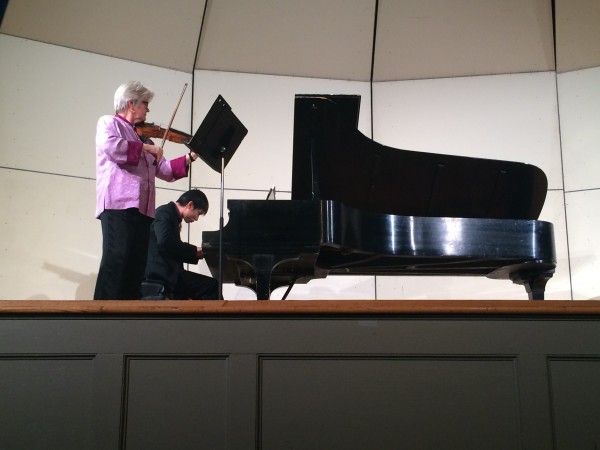
Fashions may fade and trends may end, but classical music is something that has lasted for hundreds of years.
On Tuesday, March 31 in the Julien J. Studley theater, the SUNY New Paltz Department of Music’s concert series continued with a performance entitled “Violin and Piano.” SUNY New Paltz professors of music Carole Cowan and Alex Peh performed several duets, with classical and folk influences by composers such as Wolfgang Amadeus Mozart, Igor Stravinsky and Bela Bartok. Cowan played the violin while Peh was the featured pianist.
The concert featured two pieces by Mozart entitled “Sonata for Piano and Violin in E Minor, KV 304” and “Sonata for Piano and Violin in G Major, KV 301.” Both pieces included two movements. The E minor sonatas’ movements were entitled “Allegro” and “Tempo Di Menuetto.” The G major sonatas’ movements were entitled “Allegro Con Spirito” and “Allegro.” Both pieces were great and featured exemplary playing from Cowan and Peh.
According to the program, these pieces were written in 1778 and were dedicated to the Countess of Pfalz. The majority of this region in the Hudson Valley was settled by people from the Pfalz area of the Rhineland in Germany.
After a short break, Cowan and Peh came back out on stage to perform my favorite piece of the evening: “Duo Concertante for Violin and Piano” by Igor Stravinsky. The piece was quite a bit longer than Mozart’s two pieces and contained five movements entitled “Cantilene,” “Eglogue I,” “Eglogue II,” “Gigue” and “Dithyrambe.” It was written in 1933.
I hadn’t heard this particular Stravinsky piece before, but since he has always been one of my favorite composers I knew I wouldn’t be disappointed. According to the program, Stravinsky was hesitant to write for violin and piano at first since he didn’t think he knew enough about string technique. He began working with violinist Samuel Dushkin and they explored the contrasts, competitive qualities, similarities and interesting combinations that were possible with violin and piano. The two eventually became a duo and performed together on many occasions. Cowan and Peh delivered a great rendition of Stravinsky’s piece.
For the final piece of the evening, Cowan and Peh performed a duet entitled “Second Rhapsody ‘Folk Dances’” which was composed by Bela Bartok. The piece contained two movements entitled “Iassu” and “Friss.” I hadn’t heard a Bartok piece prior to this performance and I was very impressed by what I heard. The rhythms were interesting, and each of the two movements within the piece greatly captured my attention. It was written in 1928.
While Stravinsky and Mozart’s piece had a more classical feel to it, Bartok’s had a folkier feel to it. According to the program, Bartok traveled throughout Europe a lot and visited places such as Transylvania, Rumania and Ruthenia. His music combines modes, fiddle dances, language inflections, drones and a folk energy with modern techniques and dissonance.
Bartok’s piece was a welcome inclusion in the concert’s set list because of how different it was compared to the other three pieces. Cowan and Peh delivered a great rendition of Bartok’s piece and it was a successful way to end the performance.
